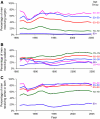Prostate cancer diagnosis and treatment after the introduction of prostate-specific antigen screening: 1986-2005
- PMID: 19720969
- PMCID: PMC2758309
- DOI: 10.1093/jnci/djp278
Prostate cancer diagnosis and treatment after the introduction of prostate-specific antigen screening: 1986-2005
Abstract
Background: Although there is uncertainty about the effect of prostate-specific antigen (PSA) screening on the rate of prostate cancer death, there is little uncertainty about its effect on the rate of prostate cancer diagnosis. Systematic estimates of the number of men affected, however, to our knowledge, do not exist.
Methods: We obtained data on age-specific incidence and initial course of therapy from the National Cancer Institute's Surveillance, Epidemiology, and End Results program. We then used age-specific male population estimates from the US Census to determine the excess (or deficit) in the number of men diagnosed and treated in each year after 1986-the year before PSA screening was introduced.
Results: Overall incidence of prostate cancer rose rapidly after 1986, peaked in 1992, and then declined, albeit to levels considerably higher than those in 1986. Overall incidence, however, obscured distinct age-specific patterns: The relative incidence rate (2005 relative to 1986) was 0.56 in men aged 80 years and older, 1.09 in men aged 70-79 years, 1.91 in men aged 60-69 years, 3.64 in men aged 50-59 years, and 7.23 in men younger than 50 years. Since 1986, an estimated additional 1 305 600 men were diagnosed with prostate cancer, 1 004 800 of whom were definitively treated for the disease. Using the most optimistic assumption about the benefit of screening-that the entire decline in prostate cancer mortality observed during this period is attributable to this additional diagnosis-we estimated that, for each man who experienced the presumed benefit, more than 20 had to be diagnosed with prostate cancer.
Conclusions: The introduction of PSA screening has resulted in more than 1 million additional men being diagnosed and treated for prostate cancer in the United States. The growth is particularly dramatic for younger men. Given the considerable time that has passed since PSA screening began, most of this excess incidence must represent overdiagnosis.
Figures



Comment in
-
Prostate cancer screening; is this a teachable moment?J Natl Cancer Inst. 2009 Oct 7;101(19):1295-7. doi: 10.1093/jnci/djp310. Epub 2009 Aug 31. J Natl Cancer Inst. 2009. PMID: 19720970 No abstract available.
-
Re: Prostate cancer diagnosis and treatment after the introduction of prostate-specific antigen screening: 1986-2005.J Natl Cancer Inst. 2010 Apr 7;102(7):506-7. doi: 10.1093/jnci/djq045. Epub 2010 Feb 26. J Natl Cancer Inst. 2010. PMID: 20190186 No abstract available.
References
-
- Schilling F, Spix C, Berthold F, et al. Neuroblastoma screening at one year of age. N Engl J Med. 2002;346(14):1265–1269. - PubMed
-
- Yamamoto K, Hanada R, Kikuchi A, et al. Spontaneous regression of localized neuroblastoma detected by mass screening. J Clin Oncol. 1998;16(4):1265–1269. - PubMed
-
- Davies L, Welch H. The increasing incidence of thyroid cancer in the United States, 1973-2002. JAMA. 2006;295(18):2164–2167. - PubMed
Publication types
MeSH terms
Substances
Grants and funding
LinkOut - more resources
Full Text Sources
Other Literature Sources
Medical
Research Materials
Miscellaneous

